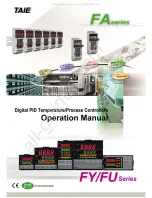
3-
4
3
I/O INTERF
ACE
3-2 Input Signal Description
■
Absolute point movement command (ABS-PT)
This command moves the robot to an absolute position specified by a point number at a specified
speed along an axis coordinate whose origin is defined as 0. The point number and speed are
specified by general-purpose input. (See "3-2-2 General-purpose input (DI0 to DI7)".)
n
NOTE
The number of general-purpose input (DI) points used to specify the point numbers and speed differs depending on
whether SERVICE mode is enabled or disabled and also on the PRM7 (I/O point movement command speed
parameter) setting. (See "3-2-2 General-purpose input (DI0 to DI7)".)
c
CAUTION
The DI0 to DI7 (DI0 to DI6 when SERVICE mode is enabled) status must be confirmed before ABS-PT is
executed. (See "3-6-6 When executing a point movement command".)
■
Relative point movement command (INC-PT)
This command moves the robot a distance specified by a point number from the current position
at a specified speed. The point number and speed are specified by general-purpose input. (See "3-
2-2 General-purpose input (DI0 to DI7)".)
n
NOTE
Current position does not always indicate the actual robot position. More accurately, it is the current position data
stored in the controller. Each time a movement command is executed correctly, the current position data in the
controller is replaced with the target position data of the movement command.
Therefore, if the robot is stopped by an interlock while executing a relative movement command, re-executing the
same relative movement command moves the robot to the target position. (The robot does not move a relative
distance from the stopped position by the interlock.)
Similarly, after a robot movement command is executed, the controller still retains the target position data of that
movement command as the current position data even if you move the robot to another position by manual
operation.
When a relative movement command is executed under this condition, the robot moves the specified distance from
the target position of the movement command that was previously executed, rather than the actual robot position, so
use caution.
Current position data differs from the actual robot position when:
• Emergency stop or interlock (LOCK) was activated while the robot was moving.
• A communication command ^C (movement interruption) was transmitted while the robot was moving.
• The SERVICE mode input was changed while the robot was moving.
• The robot was moved by manual operation.
• The robot was moved by hand during servo-off (including emergency stop).
n
NOTE
The number of general-purpose input (DI) points used to specify the point numbers and speed differs depending on
whether SERVICE mode is enabled or disabled and also on the PRM7 (I/O point movement command speed
parameter) setting. (See "3-2-2 General-purpose input (DI0 to DI7)".)
c
CAUTION
The DI0 to DI7 (DI0 to DI6 when SERVICE mode is enabled) status must be specified before INC-PT is
executed. (See "3-6-6 When executing a point movement command".)
■
Automatic operation start command (AUTO-R)
This command executes the robot program continuously, starting from the current step.
All tasks are executed if the robot program is a multi-task program.
■
Step operation start command (STEP-R)
This command executes the robot program one step at a time, starting from the current step.
Only the selected task is executed even if the robot program is a multi-task program.
Summary of Contents for SRCP
Page 1: ...User s Manual ENGLISH E YAMAHA SINGLE AXIS ROBOT CONTROLLER E84 Ver 2 04 SRCP ...
Page 2: ......
Page 8: ...vi MEMO ...
Page 18: ...1 10 MEMO ...
Page 28: ...2 10 MEMO ...
Page 132: ...8 34 MEMO ...
Page 146: ...9 14 MEMO ...
Page 176: ...10 30 MEMO ...
Page 218: ...12 10 MEMO ...
Page 235: ...15 1 15 SPECIFICATIONS Chapter 15 SPECIFICATIONS ...
Page 240: ...MEMO 15 6 ...
Page 241: ...16 1 16 APPENDIX Chapter 16 APPENDIX ...
Page 245: ...MEMO ...
















































